Analys
SHB Råvarubrevet 25 oktober 2013

 Råvaror allmänt
Råvaror allmänt
Nu märks USA-effekten
Senaste veckan har bjudit på tillfälligt dystrare ekonomiska utsikter efter den finanspolitiska turbulensen i USA. Nedstängningen av den federala staten slår automatiskt på BNP-tillväxten under det fjärde kvartalet. Intressant är vilka effekter den förhöjda osäkerheten i USA (skuldtaksfrågan är ju bara framskjuten till början av nästa år) kommer att få på investerings- och konsumtionsbeslut, även om denna osäkerhet har minskat något sedan en överenskommelse kom på plats. Offentliganställda har flera viktiga deadlines att beakta – stundar ännu en nedstängning i januari? Marknadens förväntningar på en nedskalning av Federal Reserves obligationsköparprogram, QE3, har också förändrats tydligt den senaste månaden. Från att en nästan enhällig ekonomkår trodde på en nedskalning i september är konsensus nu snarare mars 2014. Bland råvarorna har det främst prisats in i guld som handlas på 4 veckors högsta.
Vårt tema där Kina ska stå för höstens positiva makroöverraskning håller i sig. Flashen för inköpschefsindex kom in under veckan på 50,9, upp från 50,2 i september och den högsta nivån på 7 månader. Basmetallerna är dock fortsatt ”rangehandlade”, klämda mellan starkare utsikter för efterfrågan från Kina och ett produktionsöverskott i marknaden.
Brentpriset ser denna vecka ut att gå mot det största raset på 4 månader. Orsakerna till prisuppgången i augusti verkar nu omvänt. Lagernivåerna i USA steg under veckan oväntat mycket – i somras föll de oväntat mycket. Den politiska turbulensen i Mellanöstern har också hamnat utanför kameralinsen senaste veckorna vilket prisar ur mer av riskpremien. När elpriset dessutom har haft två svaga veckor efter väderomslag med stor nederbörd och blötare prognoser så har vårt energiindex tappat sin starka trend uppåt. Vi tror dock på en come back, främst för el i närtid.
Basmetaller
Lagerproblematik pressar upp fysisk premie
Basmetallerna har stärkts över lag under veckan, dels på grund av positiv PMI-flash från Kina, och vi tror på en fortsatt stark höst. LME Index har stabiliserats efter sommarens bottennoteringar och vi räknar med att den positiva trenden fortsätter utan några dramatiska rörelser. Överskottet bör ha diskonterats för och läget på metaller kanske bäst illustreras genom bilden nedan där Nickel och Aluminium är de två metaller som handlas på störst rabatt sett i förhållande till marginalkostnad.
Ser vi till Aluminium och Zink förstärks balansen ytterligare av de lager som förväntas nå marknaden i samband med LME´s eventuella reglering för att få bukt på flaskhalsarna, dvs köerna som drivit upp fysiska premierna 100-200 procent över 10-års snittet samtidigt som börskurserna ligger kvar kring 10-års snittet. På Aluminium innebär det sannolikt att vi börjar röra oss tillbaka mot normalnivån om ca 100 dollar (från de 250-300 dollar vi sett) så vi förväntar oss att LME inom kort ger besked kring dessa regleringar som i stora drag skall se till att lika mycket metall går ut som kommer in, med implementeringstart från april nästa år.
Vi tror att Kinas tillväxt kommer överraska positivt under Q4 och Q1, vilket kommer stärka metallerna. Vi tror på: LONG BASMETALLER
Ädelmetaller
Återigen oro för strejk i Sydafrika
Guldet handlas upp 1.5 procent med visst stöd från ETF-flöden och en försvagad dollar där EURUSD för första gången på två år passerade 1.38. Platina stiger med ungefär lika mycket och ökat fokus på den förnyade strejkoron i Sydafrika. AMCU-facket misslyckades i sina löneförhandlingar gentemot Anglo American (världens största Platinaproducent) och det radikala facket är sedan tidigare i konflikt med Impala Platinum (världens näst största Platinaproducent), där alla försök till medling misslyckats. AMCU skall i början av nästa vecka besluta om man skall gå ut i strejk vid Impala. Kortsiktigt stöd om man ser till dollarutvecklingen och oron kring Sydafrika men vi räknar med att guldet sedan faller tillbaka i den mer långsiktigt negativa trend där vi befinner oss.
Efter en uppgång under sommaren tror vi åter att guldets väg lutar utför. Vi tror på: SHRT GULD H
Energi
Höga lager pressar oljan
Oljepriset har fallit under veckan till följd av stigande lager (högsta nivå sedan juni) och handlas nu på 106,6 USD/fat. Oro för kortsiktigt överskott av amerikansk råolja har fått spreaden mellan WTI och Brent-olja att gå isär, som mest under veckan på dryga 11 dollar, vilket är störst sedan april. Kombinationen av växande nordamerikanska produktionen, nya rörledningar till den amerikanska gulfkusten och storskaliga revisionsstopp på raffinaderier är anledningen till att WTI-oljan handlas så mycket lägre än Brent.
Elmarknaden (Q1-14) backar med närmare 5 procent under veckan efter att vädret slagit om och lågtrycket drivit stora nederbördsfronter rakt in mot framförallt Norge. Som mest uppmättes hela 3.5 TWh nederbördsenergi i Norge och Sverige under tisdagen och detta är enligt statistik den mest nederbördsrika dag mätt till energimängd på hela 10 år! Även den höga temperaturen har överraskat och i södra Sverige noterades 19 grader vilket är den högsta temperaturen på över 125 år! Ser vi till energibalansen bör den såldes förbättras till 15.6 TWh i underskott med prognoserna. Kolet får stöd av en svagare dollar, fraktrater samt marginalkostnad för produktion vilken inte motiverar full produktion på dessa låga nivåer. Utsläppsrätterna som bröt igenom 5 EUR-nivån har nu återhämtat sig vilket resulterar i att brytpriset för kol nu stigit med 3 euro. När de värsta lågtrycksbetonade vädret dragit förbi ser vi åter elen som köpvärd inför vintern.
Energiunderskott tillsammans med osäkerhet kring kärnkraftsverken inför vintern talar för högre elpris. Vi tror på: LONG EL
Livsmedel
Vetet är fortsatt starkt
Prisuppgången på vete den senaste tiden (6,9 % under oktober) är driven av problemen i Ryssland och Argentina, med stöd av producenternas ovilja att sälja i en stigande marknad. Det ser ut att ha blivit något torrare i Ryssland men den sådd som görs nu görs sent och under blöta förhållanden. Omkring 5 procent av vårveteskörden återstår i Ryssland, den del av detta som blir skördat håller låg kvalitet. Utan nya problem inom kort blir vi inte förvånade om vi ser ytterligare korrigering nedåt den närmsta tiden. Det finns trots allt gott om spannmål att tillgå i världen och ännu mer på ingång.
Skörden på sojabönor i USA går framåt, till helgen beräknas omkring 85 procent av skörden vara avklarad. Inkommande skörderapporter talar för en avkastning på åtminstone 42 bushels per acre. Sojasådden i Brasilien går framåt i rask i bra takt under bra förhållanden, vilket stärker tron om en kommande rekordskörd. Det tillsammans med höga förväntningar på en stor amerikansk sojaareal till våren talar för lägre priser på soja på några månaders sikt.
Med anledning av ett ökat intresse kring kaffe har vi i skrivit lite mer ingående om denna lyxiga råvara. Läs Kaffe Special Edition.
Handelsbankens Råvaruindex
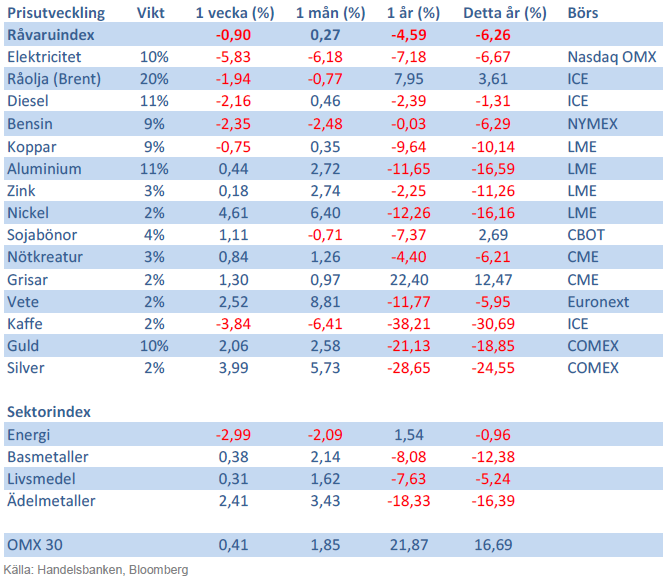
Handelsbankens råvaruindex består av de underliggande indexen för respektive råvara. Vikterna är bestämda till hälften från värdet av nordisk produktion (globala produktionen för sektorindex) och till hälften från likviditeten i terminskontrakten.
[box]SHB Råvarubrevet är producerat av Handelsbanken och publiceras i samarbete och med tillstånd på Råvarumarknaden.se[/box]
Ansvarsbegränsning
Detta material är producerat av Svenska Handelsbanken AB (publ) i fortsättningen kallad Handelsbanken. De som arbetar med innehållet är inte analytiker och materialet är inte oberoende investeringsanalys. Innehållet är uteslutande avsett för kunder i Sverige. Syftet är att ge en allmän information till Handelsbankens kunder och utgör inte ett personligt investeringsråd eller en personlig rekommendation. Informationen ska inte ensamt utgöra underlag för investeringsbeslut. Kunder bör inhämta råd från sina rådgivare och basera sina investeringsbeslut utifrån egen erfarenhet.
Informationen i materialet kan ändras och också avvika från de åsikter som uttrycks i oberoende investeringsanalyser från Handelsbanken. Informationen grundar sig på allmänt tillgänglig information och är hämtad från källor som bedöms som tillförlitliga, men riktigheten kan inte garanteras och informationen kan vara ofullständig eller nedkortad. Ingen del av förslaget får reproduceras eller distribueras till någon annan person utan att Handelsbanken dessförinnan lämnat sitt skriftliga medgivande. Handelsbanken ansvarar inte för att materialet används på ett sätt som strider mot förbudet mot vidarebefordran eller offentliggörs i strid med bankens regler.
Analys
More weakness and lower price levels ahead, but the world won’t drown in oil in 2026

Some rebound but not much. Brent crude rebounded 1.5% yesterday to $65.47/b. This morning it is inching 0.2% up to $65.6/b. The lowest close last week was on Thursday at $64.11/b.

The curve structure is almost as week as it was before the weekend. The rebound we now have gotten post the message from OPEC+ over the weekend is to a large degree a rebound along the curve rather than much strengthening at the front-end of the curve. That part of the curve structure is almost as weak as it was last Thursday.
We are still on a weakening path. The message from OPEC+ over the weekend was we are still on a weakening path with rising supply from the group. It is just not as rapidly weakening as was feared ahead of the weekend when a quota hike of 500 kb/d/mth for November was discussed.
The Brent curve is on its way to full contango with Brent dipping into the $50ies/b. Thus the ongoing weakening we have had in the crude curve since the start of the year, and especially since early June, will continue until the Brent crude oil forward curve is in full contango along with visibly rising US and OECD oil inventories. The front-month Brent contract will then flip down towards the $60/b-line and below into the $50ies/b.
At what point will OPEC+ turn to cuts? The big question then becomes: When will OPEC+ turn around to make some cuts? At what (price) point will they choose to stabilize the market? Because for sure they will. Higher oil inventories, some more shedding of drilling rigs in US shale and Brent into the 50ies somewhere is probably where the group will step in.
There is nothing we have seen from the group so far which indicates that they will close their eyes, let the world drown in oil and the oil price crash to $40/b or below.
The message from OPEC+ is also about balance and stability. The world won’t drown in oil in 2026. The message from the group as far as we manage to interpret it is twofold: 1) Taking back market share which requires a lower price for non-OPEC+ to back off a bit, and 2) Oil market stability and balance. It is not just about 1. Thus fretting about how we are all going to drown in oil in 2026 is totally off the mark by just focusing on point 1.
When to buy cal 2026? Before Christmas when Brent hits $55/b and before OPEC+ holds its last meeting of the year which is likely to be in early December.
Brent crude oil prices have rebounded a bit along the forward curve. Not much strengthening in the structure of the curve. The front-end backwardation is not much stronger today than on its weakest level so far this year which was on Thursday last week.

The front-end backwardation fell to its weakest level so far this year on Thursday last week. A slight pickup yesterday and today, but still very close to the weakest year to date. More oil from OPEC+ in the coming months and softer demand and rising inventories. We are heading for yet softer levels.

Analys
A sharp weakening at the core of the oil market: The Dubai curve

Down to the lowest since early May. Brent crude has fallen sharply the latest four days. It closed at USD 64.11/b yesterday which is the lowest since early May. It is staging a 1.3% rebound this morning along with gains in both equities and industrial metals with an added touch of support from a softer USD on top.

What stands out the most to us this week is the collapse in the Dubai one to three months time-spread.
Dubai is medium sour crude. OPEC+ is in general medium sour crude production. Asian refineries are predominantly designed to process medium sour crude. So Dubai is the real measure of the balance between OPEC+ holding back or not versus Asian oil demand for consumption and stock building.
A sharp weakening of the front-end of the Dubai curve. The front-end of the Dubai crude curve has been holding out very solidly throughout this summer while the front-end of the Brent and WTI curves have been steadily softening. But the strength in the Dubai curve in our view was carrying the crude oil market in general. A source of strength in the crude oil market. The core of the strength.
The now finally sharp decline of the front-end of the Dubai crude curve is thus a strong shift. Weakness in the Dubai crude marker is weakness in the core of the oil market. The core which has helped to hold the oil market elevated.
Facts supports the weakening. Add in facts of Iraq lifting production from Kurdistan through Turkey. Saudi Arabia lifting production to 10 mb/d in September (normal production level) and lifting exports as well as domestic demand for oil for power for air con is fading along with summer heat. Add also in counter seasonal rise in US crude and product stocks last week. US oil stocks usually decline by 1.3 mb/week this time of year. Last week they instead rose 6.4 mb/week (+7.2 mb if including SPR). Total US commercial oil stocks are now only 2.1 mb below the 2015-19 seasonal average. US oil stocks normally decline from now to Christmas. If they instead continue to rise, then it will be strongly counter seasonal rise and will create a very strong bearish pressure on oil prices.
Will OPEC+ lift its voluntary quotas by zero, 137 kb/d, 500 kb/d or 1.5 mb/d? On Sunday of course OPEC+ will decide on how much to unwind of the remaining 1.5 mb/d of voluntary quotas for November. Will it be 137 kb/d yet again as for October? Will it be 500 kb/d as was talked about earlier this week? Or will it be a full unwind in one go of 1.5 mb/d? We think most likely now it will be at least 500 kb/d and possibly a full unwind. We discussed this in a not earlier this week: ”500 kb/d of voluntary quotas in October. But a full unwind of 1.5 mb/d”
The strength in the front-end of the Dubai curve held out through summer while Brent and WTI curve structures weakened steadily. That core strength helped to keep flat crude oil prices elevated close to the 70-line. Now also the Dubai curve has given in.
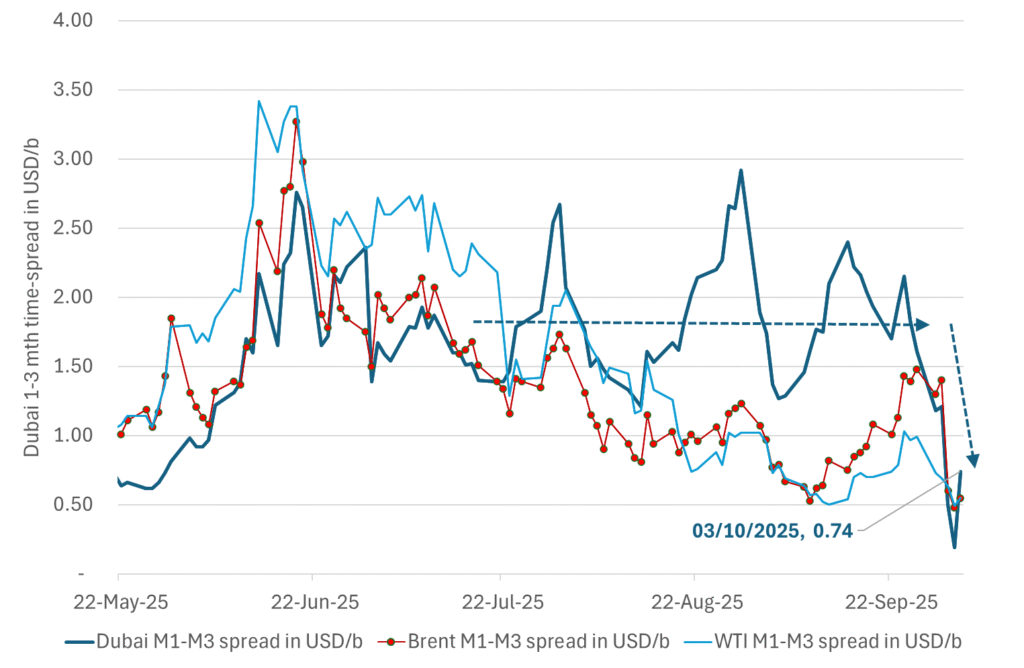
Brent crude oil forward curves

Total US commercial stocks now close to normal. Counter seasonal rise last week. Rest of year?
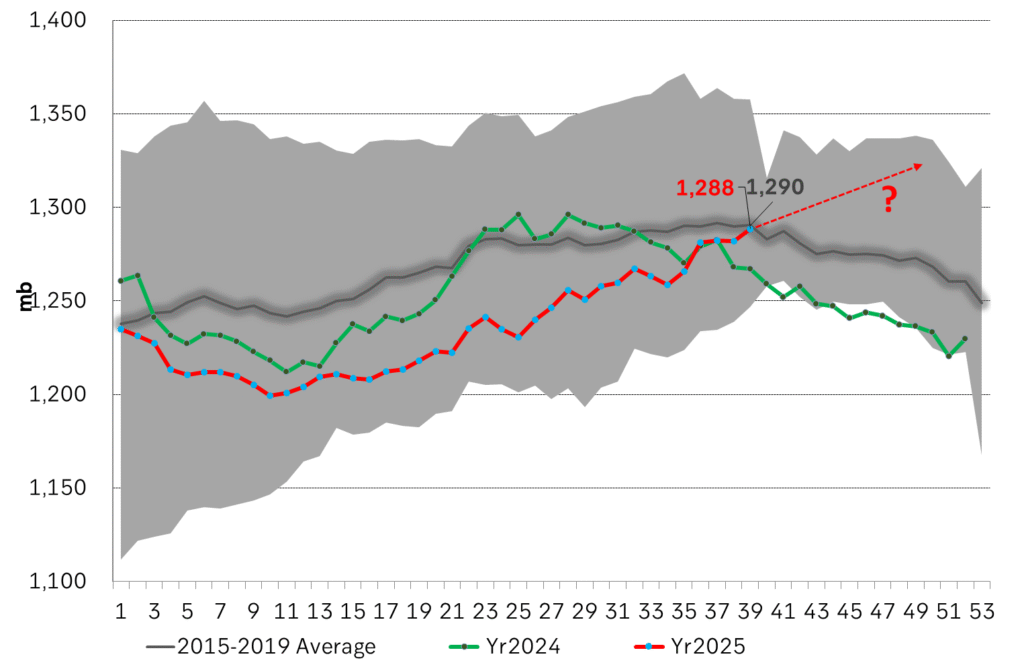
Total US crude and product stocks on a steady trend higher.
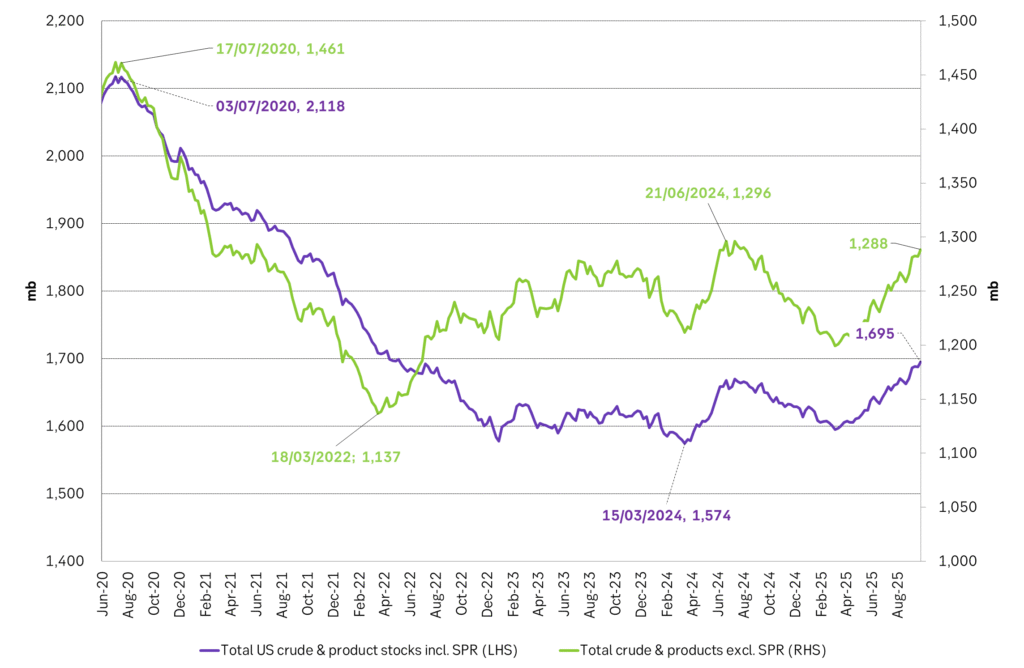
Analys
OPEC+ will likely unwind 500 kb/d of voluntary quotas in October. But a full unwind of 1.5 mb/d in one go could be in the cards

Down to mid-60ies as Iraq lifts production while Saudi may be tired of voluntary cut frugality. The Brent December contract dropped 1.6% yesterday to USD 66.03/b. This morning it is down another 0.3% to USD 65.8/b. The drop in the price came on the back of the combined news that Iraq has resumed 190 kb/d of production in Kurdistan with exports through Turkey while OPEC+ delegates send signals that the group will unwind the remaining 1.65 mb/d (less the 137 kb/d in October) of voluntary cuts at a pace of 500 kb/d per month pace.

Signals of accelerated unwind and Iraqi increase may be connected. Russia, Kazakhstan and Iraq were main offenders versus the voluntary quotas they had agreed to follow. Russia had a production ’debt’ (cumulative overproduction versus quota) of close to 90 mb in March this year while Kazakhstan had a ’debt’ of about 60 mb and the same for Iraq. This apparently made Saudi Arabia angry this spring. Why should Saudi Arabia hold back if the other voluntary cutters were just freeriding? Thus the sudden rapid unwinding of voluntary cuts. That is at least one angle of explanations for the accelerated unwinding.
If the offenders with production debts then refrained from lifting production as the voluntary cuts were rapidly unwinded, then they could ’pay back’ their ’debts’ as they would under-produce versus the new and steadily higher quotas.
Forget about Kazakhstan. Its production was just too far above the quotas with no hope that the country would hold back production due to cross-ownership of oil assets by international oil companies. But Russia and Iraq should be able to do it.
Iraqi cumulative overproduction versus quotas could reach 85-90 mb in October. Iraq has however steadily continued to overproduce by 3-5 mb per month. In July its new and gradually higher quota came close to equal with a cumulative overproduction of only 0.6 mb that month. In August again however its production had an overshoot of 100 kb/d or 3.1 mb for the month. Its cumulative production debt had then risen to close to 80 mb. We don’t know for September yet. But looking at October we now know that its production will likely average close to 4.5 mb/d due to the revival of 190 kb/d of production in Kurdistan. Its quota however will only be 4.24 mb/d. Its overproduction in October will thus likely be around 250 kb/d above its quota with its production debt rising another 7-8 mb to a total of close to 90 mb.
Again, why should Saudi Arabia be frugal while Iraq is freeriding. Better to get rid of the voluntary quotas as quickly as possible and then start all over with clean sheets.
Unwinding the remaining 1.513 mb/d in one go in October? If OPEC+ unwinds the remaining 1.513 mb/d of voluntary cuts in one big go in October, then Iraq’s quota will be around 4.4 mb/d for October versus its likely production of close to 4.5 mb/d for the coming month..
OPEC+ should thus unwind the remaining 1.513 mb/d (1.65 – 0.137 mb/d) in one go for October in order for the quota of Iraq to be able to keep track with Iraq’s actual production increase.
October 5 will show how it plays out. But a quota unwind of at least 500 kb/d for Oct seems likely. An overall increase of at least 500 kb/d in the voluntary quota for October looks likely. But it could be the whole 1.513 mb/d in one go. If the increase in the quota is ’only’ 500 kb/d then Iraqi cumulative production will still rise by 5.7 mb to a total of 85 mb in October.
Iraqi production debt versus quotas will likely rise by 5.7 mb in October if OPEC+ only lifts the overall quota by 500 kb/d in October. Here assuming historical production debt did not rise in September. That Iraq lifts its production by 190 kb/d in October to 4.47 mb/d (August level + 190 kb/d) and that OPEC+ unwinds 500 kb/d of the remining quotas in October when they decide on this on 5 October.
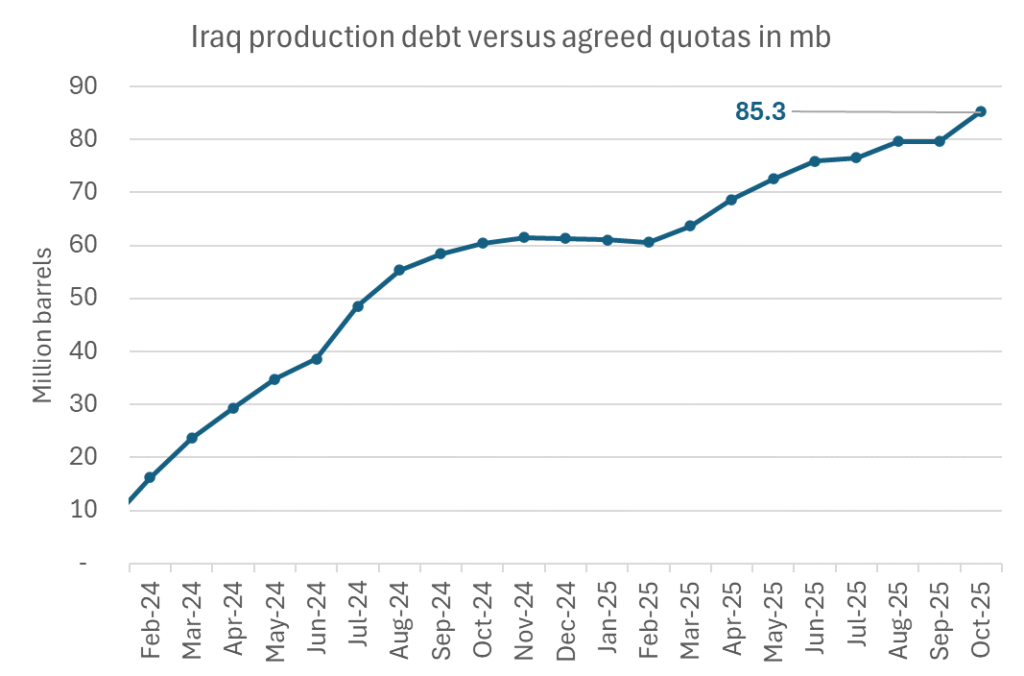
-

 Nyheter4 veckor sedan
Nyheter4 veckor sedanMahvie Minerals i en guldtrend
-

 Nyheter4 veckor sedan
Nyheter4 veckor sedanOPEC signalerar att de inte bryr sig om oljepriset faller kommande månader
-

 Analys4 veckor sedan
Analys4 veckor sedanVolatile but going nowhere. Brent crude circles USD 66 as market weighs surplus vs risk
-
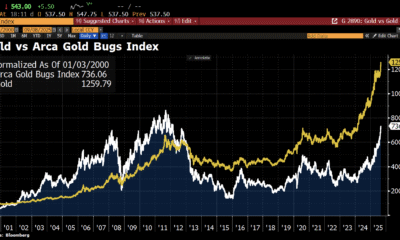
 Nyheter4 veckor sedan
Nyheter4 veckor sedanAktier i guldbolag laggar priset på guld
-

 Nyheter3 veckor sedan
Nyheter3 veckor sedanKinas elproduktion slog nytt rekord i augusti, vilket även kolkraft gjorde
-

 Nyheter3 veckor sedan
Nyheter3 veckor sedanTyskland har så höga elpriser att företag inte har råd att använda elektricitet
-

 Nyheter4 veckor sedan
Nyheter4 veckor sedanGuld når sin högsta nivå någonsin, nu även justerat för inflation
-

 Nyheter3 veckor sedan
Nyheter3 veckor sedanDet stigande guldpriset en utmaning för smyckesköpare













